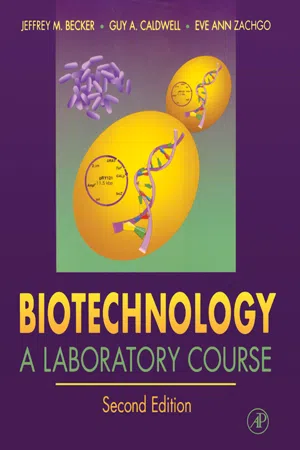Introduction
The utilization of microbes in biotechnology depends on pure cultures, which consist of only a single species, and the maintenance of the purity of the isolates through subsequent manipulations (see Appendix 8, Storage of Cultures and DNA). Most applications in biotechnology involve the use of pure cultures.
Most methods for obtaining pure cultures rely on some form of dilution technique. The most useful and pragmatic method is the streak plate, in which a mixed culture is spread or streaked over the medium surface in such a way that individual cells become separated from one another. Each isolated cell grows into a colony and, therefore, a pure culture (or clone) because cells are the progeny of the original single cell.
There are several checks to establish the purity of a culture.
1. On restreaking, an isolated colony from an initial streak plate should yield only a single type of isolated colony whose colonial morphology is consistent with the initial isolate.
2. Microscopic examination of the organisms from a colony should reveal only a single type of cell; differential staining procedures, such as the gram stain, are useful for establishing that the colony does not contain a mixture of different microbial types.
There is more than one method for obtaining a good streak plate and each method requires some practice. It is important to remember that the more cells one starts with on the inoculating loop, the more streaking (dilution) is required. It is not necessary to start with large amounts or “gobs” of culture material on loops. For this laboratory exercise, we will use two different streak plate procedures.
Aseptic technique is required to transfer pure cultures and to maintain sterility of media and solutions (see Appendix 6, Safe Handling of Microorganisms). By aseptic technique the biotechnologist takes prudent precautions to prevent contamination of the culture or solutions by unwanted microbes. Many of the petri dishes and tissue culture plates that are used for growing pure cultures of microorganisms are made of plastic and come presterilized from the manufacturer; filling these vessels with a sterile medium requires the use of aseptic technique. Proper aseptic transfer technique also protects the biotechnologist from contamination with the culture, which should always be treated as a potential pathogen. Aseptic technique involves avoiding any contact between the pure culture, sterile medium, and sterile surfaces of the growth vessel with contaminating microorganisms. To accomplish this task, (1) the work area is cleansed with an antiseptic to reduce the numbers of potential contaminants; (2) the transfer instruments are sterilized; for example, the transfer loop is sterilized by heating with a Bunsen burner before and after transferring; and (3) the work is accomplished quickly and efficiently to minimize the time of exposure during which the contamination of the culture or laboratory worker can occur.
The typical steps for transferring a culture from one vessel to another are as follows: (1) flame the transfer loop; (2) open and flame the mouths of the culture tubes; (3) pick up some of the culture growth and transfer it to the fresh medium; (4) flame the mouths of the culture vessels and reseal them; and (5) reflame the inoculating loop. Essentially the same technique is used for inoculating petri dishes, except that the dish is not flamed, and for transferring microorganisms from a culture vessel to a microscope slide.
Developing a thorough understanding and knowledge of aseptic technique and culture transfer procedures is a prerequisite for working with microbiological cultures. You will save yourself a lot of time and energy and will avoid erroneous results if a few simple and commonsense rules are observed when working with cultures.
1. Always sterilize the inoculating loop by flaming before using it to enter any culture material.
2. Always flame the lip of the culture tube before inserting the sterile loop into the culture. This destroys any contaminating cells that may have been inadvertently deposited near the lip of the tube during previous transfer or by other means.
3. Keep all culture materials covered with their respective caps and lids when not making transfers. Do not lay tube caps or petri dish lids on the tabletop, thereby exposing cultures to possible contamination. When transferring colonies from petri plates, use the lid as a shield by slightly raising it enough so that the loop can be inserted but the agar surface is still protected from contaminants falling on it.
4. Do not allow tube closures or petri dish lids to touch anything except their respective culture containers. This will prevent contamination of closures and therefore of cultures.
5. Use proper handling procedures for closure removal and return.
Reagents/Supplies
Inoculating loops
LB agar plates [for LB agar, add agar (15 g/liter) to LB broth]
LB broth (Luria-Bertani broth: tryptone, 10 g/liter; yeast extract, 5 g/liter; NaCl, 10 g/liter; pH adjusted dropwise to 7.5 with NaOH)
Mixed culture containing Escherichia coli and Saccharomyces cerevisiae
Pure broth cultures of E. coli (strain LE392) and S. cerevisiae (strain YNN281) (see Appendix 7 for information on how to obtain these cultures)
Test tube racks
Test tubes (18 × 150 mm)
YEPD agar plates (yeast extract-pep...
